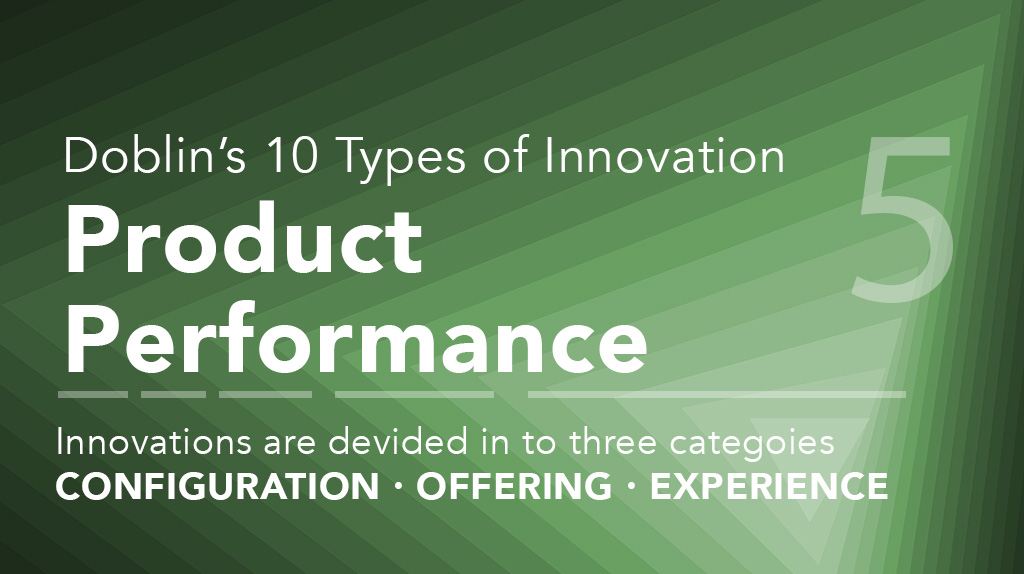Intro
In this series of posts, we will be inspecting Doblin’s 10 Types of Innovation, a popular framework for analyzing innovations in business developed by the Doblin Innovation Firm in Chicago. Innovations are divided into three categories: configuration, offering, and experience. Configuration focuses on the innermost workings of an enterprise and its business system, offering focuses on an enterprise’s core product or service, and experience focuses on customer-facing elements. In this post, we will analyze the first block in offering, product performance innovation.
Definition
Product Performance Innovation is essentially about how you develop distinguishing features and functionality. Doblin defines product performance innovation as:
“Product Performance innovations address the value, features, and quality of a company’s offering. This type of innovation involves both entirely new products as well as updates and line extensions that add substantial value. Too often, people mistake Product Performance for the sum of innovation. It’s certainly important, but it’s always worth remembering that it is only one of the Ten Types of Innovation, and it’s often the easiest for competitors to copy. Think about any product or feature war you’ve witnessed—whether torque and toughness in trucks, toothbrushes that are easier to hold and use, even with baby strollers. Too quickly, it all devolves into an expensive mad dash to parity. Product Performance innovations that deliver long-term competitive advantage are the exception rather than the rule.”
At the same time, product performance innovations can delight customers and drive growth. It is often a good place to start for innovation, and is often connected to process innovation. Product performance is considered by many to be the total sum of innovation, revolving heavily around the R&D department and a design process that develops innovative product ideas and turns those ideas into final products. Though “Service Innovation” is a different type, service companies are not exempt from product performance innovations — companies can always reevaluate the features and functionalities of their service.
Examples
Product performance innovation can take many forms, including:
- Simplification – making it easy to use an offering
- Customization – tailoring a product to an individual’s specifications
- Sustainability – providing offerings that reduces or eliminates harm on the environment
- Feature aggregation – combining the functions of multiple products into one
- Added functionality – upgrading an existing product with new features or uses
For this blog post, we will focus on simplification, customization, and sustainability.
Simplification
These product performance innovations either eliminate cumbersome processes or make existing products easier to use.
Dyson is a British technology company that manufactures household appliances like vacuum cleaners, air purifiers, hand dryers, fans, heaters, hair dryers, and lights. Dyson innovates continuously across all of their products to eliminate parts and simplify processes for the user, as seen in their bladeless fan and bag-less vacuum cleaner. As a result of their superior product performances, Dyson is able to charge customers a premium for their products.

OXO Good Grips is an American manufacturer of kitchen utensils, office supplies, and houseware. OXO initially focused on creating cookware that was ergonomically designed and easier to grasp and maneuver for customers with relatively minor motor disabilities, such as arthritis. As a result, OXO Good Grips is able to charge a premium for their tools and their brand is synonymous to smart and functional design.

A unit of the Nestle Group, Nespresso manufactures coffee machines that brew espresso and coffee from coffee capsules, a type of pre-apportioned single-use container of ground coffee beans. By utilizing these single-use containers, Nespresso eliminates the need for customers to grind their own beans, load grounds manually into coffee machines, or risk brewing more coffee than is needed. Today, Nestle is one of the largest and most successful coffee companies in the world, spawning nearly 200 copies and competitors.

FLIR Systems is the world’s largest commercial company specializing in the design and production of thermal imaging cameras, components, and imaging sensors. FLIR was first to market with a thermal imaging solution for the iPhone, an add-on hardware component that cost around $200. By taking technology that was overwhelmingly inaccessible and making it accessible to the average consumer, FLIR further solidified their dominance over the worldwide thermal imaging market while simultaneously gaining a wider audience through a consumer product.

Customization
These product performance innovations allow customers greater flexibility over their purchasing options and help create a sense of ownership.
Mars is an American multinational manufacturer of confectionery, pet food, and other food products. With My M&Ms, customers are able to customize M&Ms with their own messages, logos, and images while also being able to choose specific colors and packaging. My M&Ms allows unprecedented customization over a mass-produced food product and has helped M&Ms be seen as not only candy, but as gifting options as well.

Nike is an American multinational corporation that is engaged in the design, development, manufacturing, and worldwide marketing and sales of footwear, apparel, equipment, accessories, and services. Nike By You (formerly Nike ID) allows customers to customize their footwear, using their latest models as base designs. In a market where brand value and uniqueness are everything, Nike By You allows customers to truly express themselves through their footwear.

Apple is an American multinational tech company that designs, develops, and sells consumer electronics, computer software, and online services. Apple has a long history of customization options for their products, from being able to customize laptop specifications and preload software to free engraving on products. Apple is able to do so through their superior supply chain management, and thus is able to offer customers customization without any delay in shipping time.

Sustainability
These product performance innovations focus on reducing environmental impact in order to deliver additional value to customers.
Toyota is a Japanese multinational automotive manufacturer founded in 1937. The Toyota Prius was the first to commercialize hybrid drive technology and revolutionized the automobile landscape. The Prius continues to constitute half of all hybrids sold in the US, and Toyota owns nearly 64% of the US hybrid market.

Hewlett-Packard is an American multinational information technology company that develops and manufactures consumer electronics, hardware, and software. Their Elite Dragonfly laptop is made from 82% recycled materials, much of which is from ocean-bound plastic waste. As a result, HP is considered one of the industry leaders in creating sustainable products that reduce pollution and encourage recycling.

Impossible Foods is a company that develops plant-based substitutes for meat-products. With growing concern about the sustainability of meat production, Impossible Foods has upped the game for meat substitutes, creating some of the best tasting products on the market. Impossible Foods is one of the few recognizable meat alternative brands, creating an increased awareness and demand for meat substitutes by offering products in retailers and grocers and partnering with fast food companies.

Techniques to Develop Product Performance Innovation
Since the definition is so wide, there are many ways to develop product performance innovation. Sometimes, innovation is incremental, such as improving a product by adding features. Other times, adding customization to an existing product can be sufficient enough to be called product innovation. Developing product performance in this way is fairly easy, as most R&D departments are quite capable of improving upon existing products. However, this kind of incremental innovation does not provide a sustainable competitive advantage, as they can be easily copied by competitors if there are no protections from copyright or patents.
Thus, it is new products and supplemental products that have innovation baked into their very essence that will provide the most sustainable competitive advantage within product performance innovation. Products that are inherently designed to be easier to use, products that provide a sustainability advantage, and products that combine the functions of multiple products into one are all capable of creating and locking in new niches in markets and strengthen a company’s overall positioning.
These innovations can come from virtually anywhere: an internal R&D department or other employees, market research, or a supplier lobbying for you to use their new technology. Inspiration can even strike through a simple conversation with another person. The nature of these innovations may be enigmatic, but they are deeply rooted in people. Therefore, it is in a company’s best interest to foster work climates that encourage creativity. The more employees are empowered and stimulated to be engaged and contribute new ideas, the longer a company can sustain itself purely on internal innovation. Key drivers of a creative work environment are the attitudes of managers and leaders, team culture, work process, resource allocation, employee suitability, and organizational values.
The most crucial element of product performance innovation however is speed. The rate at which a company can generate intelligence, disseminate it internally and among partners, and respond to it directly affects their ability to be successful in the market. Without a quick innovation process, companies risk falling behind their competitors, especially companies that focus purely on incremental product innovations. These companies can find themselves in a never-ending feature war with their competitors and thus first to market advantage is paramount.
Impact
Product performance innovations ultimately have the biggest impact on consumers. After all, features and value are added into products in order to benefit them and make their lives easier. Though the overall competitive advantage that companies can attain through product innovation is minimal, continuous improvement and the addition of new products and product lines can help companies establish themselves as dominant in certain markets as well as solidify the power of their brand in the mind of consumers.
However, superior product performance does not necessarily ensure commercial success. If a company is not already clearly established as the provider of superior products in customers’ minds, differentiating itself based purely on product performance may not win over consumers. This is especially true in oversaturated and highly competitive markets with multiple competitors and never-ending product introductions. In advanced technology products like healthcare imaging products, customers may not even be able to distinguish between products. Even though many companies think that product performance innovation is the only point that’s important to the consumer, it is useless without the proper market differentiation to accompany it.
Conclusion
Product performance is a core type of innovation and what most people think of when they think of innovation, but it is a type that must be used judiciously. Product performance innovation is useless without a larger company strategy, as it can easily get lost in the noise of most marketplaces. Though it may not lead to sustaining competitive advantage, the best product innovations can be iconic and help define your company in consumers’ minds for decades to come.




